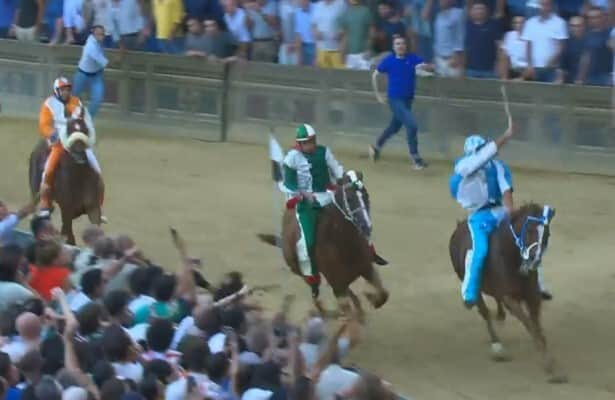Horse Racing
Video: Sanna stays on his horse to win wild Palio di Siena

For the second time in a row, Carlo Sanna rode the winner of
the Palio di Siena. This time, he stayed on the horse all the way to the
finish of this medieval version of an equine demolition derby.
Sanna guided 12-year-old gelding Tabacco to the lead near
the end of the first lap and ran on to a 1 1/2-length victory Thursday in the ancient,
bareback race that goes three times around the cramped Piazza del Campo, the
trapezoid-shaped square in central Siena.
Only four of the starters in the roughly one-mile race that
takes about 1 1/2 minutes appeared to finish it. Spills that dismount riders
are commonplace and for years have spurred protests by animal-rights activists.
All 10 participating horses were reported by the city government to have
returned to their neighborhood stables, although their conditions were not
detailed.
Sanna, 35, who goes by the nickname Brigand, and Tabacco,
who had been 0-for-6 in previous runnings of the Palio, raced for the Onda
district that is represented by blue and white colors emblematic of a wave. Onda
is one of Siena’s 17 contrade, the wards that rotate into the 10-horse race
that is run twice every summer.
The early leader was Oca, the goose district represented by
11-time-winning jockey Giovanni Atzeni, also known as Tittia. Riding 10-year-old
Veranu, Atzeni was passed when Sanna and Tabacco cut inside of him as they made
the last of the four turns before the end of the first lap.
The rest of the way, Sanna kept looking over his shoulder to
see Atzeni and Veranu lurking, but the lead did not change hands again. Veranu
finished second, which is considered more shameful in Palio culture than
finishing last.
It was the third time in 16 tries that Sanna was credited
with winning the race. That included last August, when he was dismounted from
Zio Frac with a half-lap remaining in the second 2023 Palio. Zio Frac crossed
the finish line first, and that was all that mattered since riders need not be
present on horseback to win.
The Palio endures as a holdover from the Middle Ages with
its modern era beginning in 1633. It normally is held every July 2 and Aug. 16,
but the first running this year was postponed twice because of rain that would
have made the temporary clay racing surface even more dangerous than it already
was.
Thursday’s race came after two false starts. The starter Bartolo
Ambrosione told Siena broadcasters he should have let the first attempt go
forward. Replays appeared to show the field did not leave early from between
the retaining ropes that are used during the queueing of the horses, but
Ambrosione already had made his decision, so two more lineups taking about a
half-hour were required.
Jockeys ride bareback in the Palio with their only tack
being bridles, reins and whips. They wear the colors of their wards and look
like 18th-century cavalrymen. As physical as the race can be, the only real rules
prohibit riders from attacking one another.
More than 50 horses reportedly have died in the more than 100
runnings of the Palio since 1970, making the timeless event a frequent target
of animal-rights activists while also being written into Siena’s rich, UNESCO-endorsed
history.
As usual, the
Palio course was jammed with about 40,000 spectators, most of them in the
makeshift infield. Those on the perimeter of the course have been known to pay
thousands of dollars for their vantage points in hotels, restaurants, shops and
the Siena city hall. Others who paid far less crammed themselves for hours into
the unshaded center of the square, where the views were not as favorable and
the 88-degree weather felt that much hotter.
Even before
the race was finished, fans streamed onto the course and surrounded the winer in
celebration of this rite of the Tuscan summer that will be repeated in seven
weeks.


)






